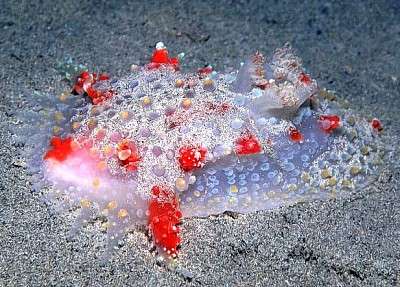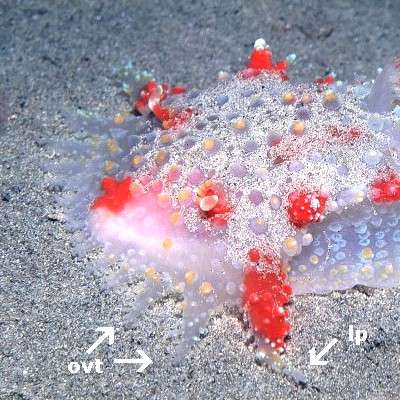Kalinga ornata from Papua New Guinea
December 2, 1999
From: Mary Jane Adams

Dear Dr. Rudman,
I recently got an e-mail from Dave Behrens about the discussion of Kalinga ornata on your Forum website. It appears that I am one of the few people to have observed and photographed this nudibranch alive and feeding. Dave asked for my permission to send you one of my photographs from the slugsite where it was featured as "BOW" for week # 119. http://siolibrary.ucsd.edu/slugsite/nudwk119.htm
While I was waiting for Terry Goslinger to I.D. it for me, I just called it "The Alien." Here is the complete story that I wrote up for Dave and Terry last year:
I found The Alien on my thirteenth dive trip to Milne Bay. I am tempted to cheat a little and say he appeared on Friday the thirteenth on the night of the full moon, but actually it was one night earlier, March 12, 1998. The location is a shallow bay near the southern end of Normanby Island at Bunama Mission. This has been used as a night anchorage by dive boats for many years. However, being a remote area of PNG, only a very few divers visit here once a month or so. As a dive site it is some times referred to as Valerie's Beach. We generally explore a stretch of about three hundred yards from the anchorage. This part of the island is typical dense hardwood rainforest. A sand beach extends about twenty feet from the waterline. Below the waterline the sand slopes gradually to about 22 feet and then falls off at a steeper angle. The upper shelf is fairly clean sand has some sparse sea grass. The deeper slope is silty and has rotting leaves and tree trunks along with some trash. It is one of the fabulous New Guinea "muck dives" where you never know what will show up. The permanent residents include amemones with A. polymnus, branching amenones, sea cucumbers, sea pens, several species of starfish, cuttlefish, octopus, bobtail squid, several species of lionfish and rare scorpionfish , filefish, juvenile boxfish, numerous blue spot sting rays and many species of molluscs, shrimps and crabs. The sand is peppered with burrows of tiny mantis shrimp and garden eels starting only ten feet deep. I photographed the Armina sp. here that Debelius (p.291) says is only known from Bali and Flores and also Euselenops luniceps.
My highlight of the day had been photographing a flamboyant cuttlefish feeding at twelve feet. This was really a hot dive spot! I found The Alien about 9 pm. It was gliding over the sand on the verge of the drop off at about 20 feet. I knew immediately that it was not like anything I have ever seen before. The overall shape was especially striking with the two big red outriggers and twelve white projections in front. The gills looked like a typical nudibranch and were the only part of it that looked at all familiar. The body is translucent white with a slightly bluish cast. Some of the pustules scattered over it are yellow capped. The row of red crab-claw like projections along each side is especially startling. When viewed from the front it really does look like a creature from outer space with the short rhinophores for eyes and the big red spot in the middle of its "face." I tried to fan the sand off of it to get better photos, but it seemed to be adherent and I was afraid it would bury itself if I touched it. I laid my hand down next to it for size comparison and estimate it was about 65 mm long. It was moving fairly rapidly and the front fringes were held just about the sand, apparently searching out food. The feeding mechanism was fascinating. It would stop and the red mouth would slowly extend beyond the fringe and then a white inner tube came out through it and retrieved tiny bits from on top of the sand.
I finished off my roll of film and left two other divers to watch him while I went back to reload and get the skipper, Dave Miller. He got some great video of The Alien feeding. He has an excellent underwater rig and uses digital videotape. He has footage of The Alien hunting and close up views of it feeding. Dave reported that The Alien eventually burrowed into the sand and disappeared. The next night I was sick and didn't dive, but Dave found it again in the same place. We came back to Valerie's Beach on March 18, but The Alien didn't make an appearance.
This is one of the most beautiful and graceful nudibranchs I have ever seen. Pictures of dead ones don't do it justice. I hope you enjoy my photo.
Mary Jane Adams
Arcadia, California
mjadams@earthlink.net
Adams, M.J., 1999 (Dec 2) Kalinga ornata from Papua New Guinea. [Message in] Sea Slug Forum. Australian Museum, Sydney. Available from http://www.seaslugforum.net/find/1624
Dear Mary Jane,
Your email was a wonderful surprise. I don't know how I missed it on Mike Miller's site - too busy looking at my own I suppose.
Your photo certainly makes sense of Kalinga's strange shape. We guessed it was a sand dweller, because it has usually been found washed up on sandy beaches or in dredge or trawl samples. Your photo shows just how well adapted it is for a sandy life. I suspect the 'sand' on its back which you tried to wash off is its own colour pattern. As with related nudibranchs, such as Plocamopherus imperialis, the row of oral veil tentacles (OVT) around the anterior end of the head are sensory as you well describe, but it is great to read your observations and see the photo of how the large anterior lateral papillae (LP)- which you call the outriggers - are used. Clearly they are also sensory and instead of standing vertically as occurs in related species, they extend down to touch the substrate and so greatly increase the span of the sensory shield which is exploring the sand as the animal crawls along.
Your description of it stopping every now and then to ingest something is very tantalising. Related nudibranchs are bryozoan feeders, but it looks as though Kalinga is feeding on something else.
The sand-dwelling fauna is a very interesting but nor well-studied area of opisthobranch biology. In the last two weeks we have had many species of Cerberilla and now Kalinga. Another quite unrelated sand-dweller, which you mention, is the pleurobranch Euselenops luniceps. I have added a couple of pages to the Forum on this fascinating animal.
Thanks Mary Jane for the wonderful photo, and thanks Dave for tracking it down.
Best wishes,
Bill Rudman.
Related messages
-
Kalinga ornata from NSW, Australia
From: Kristy Nash, November 17, 2009 -
Kalinga ornata from Singapore
From: Samson Tan, November 14, 2007 -
Re: Kalinga ornata from New South Wales
From: Lyn Cleary, December 5, 2003 -
Kalinga ornata from deepwater off Hawaii
From: Dr. Christopher Kelley, May 2, 2002 -
Spartacus - the Straddie blob
From: Lisa Miller, March 14, 2002 -
Kalinga ornata from Hong Kong
From: W.B. Rudman & B. W. Darvell, February 2, 2002 -
Re: Living Kalinga ornata
From: Andy Woerner, May 26, 2001 -
Living Kalinga ornata
From: Tim Hochgrebe, December 18, 2000 -
Kalinga ornata from New South Wales
From: Ann Lawson, November 18, 1999 -
Re: Kalinga ornata
From: Richard Willan, November 18, 1999
